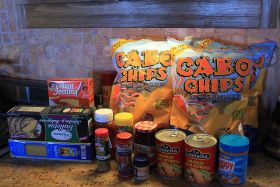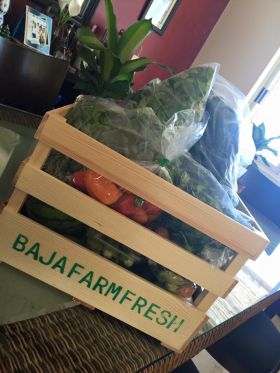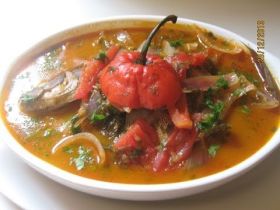How much does food cost in Los Cabos - La Paz, Mexico?
John K. Glaab - the settlement company®
 There are lots of places to shop here in Los Cabos and La Paz and the food cost here is about 65% less than how much it costs in Toronto, Canada or in Seattle, Washington. In La Paz, most of the shopping is done in the markets but we do have Wal-Mart.
There are lots of places to shop here in Los Cabos and La Paz and the food cost here is about 65% less than how much it costs in Toronto, Canada or in Seattle, Washington. In La Paz, most of the shopping is done in the markets but we do have Wal-Mart.In Cabo San Lucas, we have Costco and they have good prices, which are quite competitive. We like to support the local merchants, who sell at a lower price. About once a month, we buy a lot of things in bulk at Costco such as...
 There are lots of places to shop here in Los Cabos and La Paz and the food cost here is about 65% less than how much it costs in Toronto, Canada or in Seattle, Washington. In La Paz, most of the shopping is done in the markets but we do have Wal-Mart.
There are lots of places to shop here in Los Cabos and La Paz and the food cost here is about 65% less than how much it costs in Toronto, Canada or in Seattle, Washington. In La Paz, most of the shopping is done in the markets but we do have Wal-Mart.In Cabo San Lucas, we have Costco and they have good prices, which are quite competitive. We like to support the local merchants, who sell at a lower price. About once a month, we buy a lot of things in bulk at Costco such as certain brands of wine, which are mainly French and Italian wine that are not available in the local stores.
(Groceries delivered to the resorts in Los Cabos, Mexico, pictured.)
Posted February 11, 2016
Victoria Moate - Close It Fast
 Cabo San Lucas is filled with local, mom and pop corner grocery stores as well as having Supermarkets like Sorianna's, Chedraui, Mega and Wal-Mart. Chedraui is used more by the locals and the others seem to have a good mix of locals and expats and tourists. We also have a Costco here in Cabo San Lucas.
Cabo San Lucas is filled with local, mom and pop corner grocery stores as well as having Supermarkets like Sorianna's, Chedraui, Mega and Wal-Mart. Chedraui is used more by the locals and the others seem to have a good mix of locals and expats and tourists. We also have a Costco here in Cabo San Lucas.Fresh fish can be bought right off the docks at the marina. The fish mongers clean and filet them up right as the boats come in. For about $5.00 US, you...
 Cabo San Lucas is filled with local, mom and pop corner grocery stores as well as having Supermarkets like Sorianna's, Chedraui, Mega and Wal-Mart. Chedraui is used more by the locals and the others seem to have a good mix of locals and expats and tourists. We also have a Costco here in Cabo San Lucas.
Cabo San Lucas is filled with local, mom and pop corner grocery stores as well as having Supermarkets like Sorianna's, Chedraui, Mega and Wal-Mart. Chedraui is used more by the locals and the others seem to have a good mix of locals and expats and tourists. We also have a Costco here in Cabo San Lucas.Fresh fish can be bought right off the docks at the marina. The fish mongers clean and filet them up right as the boats come in. For about $5.00 US, you can take a pound or more of fresh tuna, mackerel or whatever the catch of the day is, home with you.
Meats are lower priced than in the US. A good porterhouse steak can be bought for about $7 US a pound. Chicken and pork are lesser priced. The nice thing about Mexico is they don't use preservatives on their meats. Eggs have wonderfully yellow yokes that make your breakfast omelet light up your plate!
There are many Mexican counterpart foods to what we have in the US. If you buy the local brands of tuna, salad dressings, etc. you will definitely pay less than the foreign (US) brands. And, not all stores carry foreign brands. However, we do have Santa Carmela Market, a boutique specialty store. The owners will happily custom order grocery and deli items from the US. My favorite item from them is molasses - a MUST for my home-made BBQ sauce!
You can buy a bottle of tequila for $3 US, a decent bottle of wine (Mexican, South American, etc) for about $3 US and loaf of fresh baked bread for about 50 cents.
The mom and pops feature less variety, but at very affordable local prices. These are the neighborhood stores that are found throughout each town and where people shop daily vs. stockpiling for weeks or months worth of food. Most Mexicans buy fresh daily, mainly because the traditional Mexican kitchen usually has a smaller refrigerator, no oven/stove combination and not a lot of kitchen cabinets.
We also have a wonderful "Farm Fresh" service available that will deliver fresh produce from local area farms right to your door every week called Baja Farm Fresh.
Many people don't realize that a large percent of our groceries and commodities are shipped in, either via truck or ferry to Cabo San Lucas. So, we do pay a somewhat higher price than the more rural communities that depend on locally available foods. And we are lucky that our selection is very big, mainly due to the amount of residents, resorts and restaurants located here.
I'd say overall, from where I live in Colorado, there is about a 40% difference in food cost, with Mexico being lower. I live in a very remote US town, where our goods are also trucked in through the mountain passes of the Rocky Mountains to Southern Colorado, so it's very similar in that respect.
Posted April 22, 2016
Ana Maria Carranza - Diamante Associates
 Here in Los Cabos and La Paz, some food is expensive and some is less expensive than in the States. Products that are imported are more expensive. If I go to La Paz and go shopping for the week, I might run it up to about 1,500 pesos (around $79) for three people, which are me, my fifteen-year-old son, and my thirteen-year-old daughter, as well as a dog and three cats. We don’t eat meat but we eat seafood, vegetables, fruits, and rice.
Here in Los Cabos and La Paz, some food is expensive and some is less expensive than in the States. Products that are imported are more expensive. If I go to La Paz and go shopping for the week, I might run it up to about 1,500 pesos (around $79) for three people, which are me, my fifteen-year-old son, and my thirteen-year-old daughter, as well as a dog and three cats. We don’t eat meat but we eat seafood, vegetables, fruits, and rice. There is a...
 Here in Los Cabos and La Paz, some food is expensive and some is less expensive than in the States. Products that are imported are more expensive. If I go to La Paz and go shopping for the week, I might run it up to about 1,500 pesos (around $79) for three people, which are me, my fifteen-year-old son, and my thirteen-year-old daughter, as well as a dog and three cats. We don’t eat meat but we eat seafood, vegetables, fruits, and rice.
Here in Los Cabos and La Paz, some food is expensive and some is less expensive than in the States. Products that are imported are more expensive. If I go to La Paz and go shopping for the week, I might run it up to about 1,500 pesos (around $79) for three people, which are me, my fifteen-year-old son, and my thirteen-year-old daughter, as well as a dog and three cats. We don’t eat meat but we eat seafood, vegetables, fruits, and rice. There is a fish market here in La Ventana (a small town 40 minutes south of La Paz) where I get my fish. The only fish that I get in La Paz is salmon because it’s imported and you don’t get salmon here in La Ventana. Here in La Ventana, I would get three large fillets of cabrilla at the fish market for 40 pesos (around $2.10), which would be about 1/2 pound. The fish that I usually buy are cabrilla (grouper), palometa (pompano), cochito or jurel (mackerel), which is more expensive, and perico (parrot fish). The cochito is really good for ceviche. You can have them grinded for you at the fish market so it’s easier for you to make the ceviche. These are all fresh fish caught in La Ventana with incredibly low prices for outrageously great fish. The fish market here is called Pescadaria Perla. You could just walk in there and buy your fresh fish. They open in the morning when the fish come in and they close early afternoon. They also do get tuna every once in a while and they always have frozen shrimp.
If you are in a place like La Ventana where they catch fish, the key to eating well for a low amount of money is to eat fish. If my family ate fish five days a week, it would be 200 pesos (around $10.50) per week on top of the 1,500 (around $79) food budget that I allot for food that I buy in the supermarkets La Paz.
The following are estimates of what common food costs in La Ventana:
Bread = 36 pesos (around $1.90)
1 gallon of milk = 55 pesos ($2.90) - available by 1 liter, 1.8 liters, and a gallon
Dozen eggs = 24 pesos (around $1.25)
(Cabrilla seafood stew, pictured.)
Posted July 19, 2016



.png)